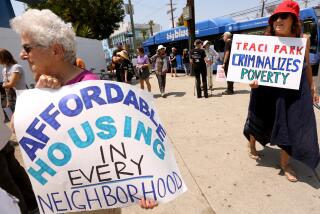Homelessness Should Not Be a Crime
- Share via
By the time night slipped over the 4th Street bridge, the homeless driven off skid row slept hungry and degraded beneath its cold underbelly. Overhead, thousands headed home to family and dinner. Below, scores of men and women slept in makeshift homes, little more than bags of garbage the city threw out of view.
Hundreds of other homeless people resisted the move to the 4th Street bridge. They spent the night with almost no protection from the elements, sleeping in cardboard boxes or huddling in dark doorways, trying to be invisible to police.
This was part of the Los Angeles Police Department’s ongoing sweeps of skid row.
The city long ago closed its 130-bed shelter on skid row, offering now just 24 cots, each available for one eight-hour shift at a time, in a tiny shelter run by a nonprofit group. This, in a neighborhood with an estimated 3,000 homeless people.
In a United States Conference of Mayors’ report, “A Status Report on Hunger and Homelessness in America’s Cities 2002,” Mayor James K. Hahn’s office wrote that in Los Angeles, “the gap between the homeless population needing a shelter bed and the inventory of shelter beds is severely large. The deficiency ... causes shelters to turn away homeless persons.”
That report lists the lack of affordable housing and necessary services, mental illness and poverty as being responsible for homelessness in Los Angeles. It states that Los Angeles is able to meet just 8% of the demand for financial assistance for housing and estimates that the city’s homeless population will continue to increase by 10% a year, as it has for the last seven years.
Yet Los Angeles’ spending on the homeless lags behind many other big cities. And for many decades, Los Angeles also has failed to get for itself much of the federal money available for homelessness and housing.
Failing to find solutions to the growing homeless crisis, the city is trying to banish it from public view.
The homeless policy is one of unrelenting police enforcement. The homeless are routinely arrested for sleeping in public. Jail, however, is an enormously expensive place to shelter the homeless.
Municipal Code 41.18 (d) forbids sitting, lying or sleeping on a public sidewalk. This has been the law for decades but was rarely enforced. Now that developers have set their sights on skid row’s 50 blocks, with its 65 low-cost hotels and large missions -- home to 11,000 elderly, handicapped and single poor -- City Hall is moving the homeless off skid row.
Downtown businesses take no responsibility for finding a solution to the homeless problem.
“We’re the business community, for God’s sake, we’re not a social group,” Tracy Lovejoy, executive director of the Central City East Assn., stated in a newspaper article in January.
In her first month in office, Councilwoman Jan Perry, whose district includes a large part of skid row, vowed to send Street Maintenance out to clean the sidewalks each day so that the homeless would have to leave.
Some insist that the homeless of skid row are just criminals or unwilling to live with rules. To be sure, some criminals live on skid row, just as some live in Beverly Hills. Mostly though, the homeless of skid row are simply those outside, dumped in a human heap under the 4th Street bridge.
*
Alice Callaghan, an Episcopal priest, directs Las Familias del Pueblo, a nonprofit community center in downtown Los Angeles.
More to Read
Sign up for Essential California
The most important California stories and recommendations in your inbox every morning.
You may occasionally receive promotional content from the Los Angeles Times.










